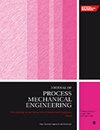利用基于 CEEMD 的振动信号去噪和 LSTM 网络预测车削过程中的表面粗糙度
IF 2.2
4区 工程技术
Q2 ENGINEERING, MECHANICAL
Proceedings of the Institution of Mechanical Engineers, Part E: Journal of Process Mechanical Engineering
Pub Date : 2024-07-26
DOI:10.1177/09544089241263456
引用次数: 0
摘要
表面粗糙度在评估加工质量中起着举足轻重的作用,许多研究都致力于主要根据切削参数预测车削过程中的表面粗糙度。然而,我们必须认识到,表面粗糙度并不仅仅受切削参数的影响,它还受到刀具特性、工件属性和当时加工条件的影响。因此,准确预测车削操作过程中的表面粗糙度对于及时采取纠正措施至关重要。然而,预测的准确性受到强烈背景噪声和使用人工特征提取的影响。为解决这些问题,本文提出了一种结合完整集合经验模式分解(CEEMD)和序列长短期记忆(LSTM)网络的新方法。CEEMD 对测量到的振动信号进行分解,并根据交叉相关性选择无噪声的本征模态函数 (IMF)。然后对无噪声的本征模态函数进行重构,得到去噪信号。去噪信号直接输入序列 LSTM 网络,这是一种基于深度学习的预测算法,用于准确预测。网络参数经过优化,误差最小。实验研究对所建议的方法进行了评估,结果表明,该方法能有效地利用振动信号预测车削过程中的表面粗糙度。此外,与其他去噪方法相比,所建议的方法被证明是有效的。所提出的方法在制造业中有着重要的应用前景,有助于改善质量控制和流程优化。本文章由计算机程序翻译,如有差异,请以英文原文为准。
Surface roughness prediction in turning processes using CEEMD-based vibration signal denoising and LSTM networks
Surface roughness plays a pivotal role in assessing machining quality, and numerous research efforts have been devoted to predicting surface roughness in turning processes primarily based on cutting parameters. However, it's important to recognize that surface roughness isn’t solely governed by cutting parameters; it is also influenced by tool characteristics, workpiece properties, and the prevailing machining conditions. Therefore, the accurate prediction of surface roughness during turning operations is of utmost importance for facilitating timely corrective measures. However, the accuracy of prediction is affected by the intense background noise and usage of manual feature extraction. To address these issues, this article proposes a novel method combining the complete ensemble empirical mode decomposition (CEEMD) and sequence long short-term memory (LSTM) networks. The CEEMD decomposes the measured vibration signals, and noise-free intrinsic mode functions (IMFs) are chosen based on cross-correlation. The noise-free IMFs are then reconstructed to get the denoised signal. The denoised signals are fed straight into the Sequence LSTM network, a deep learning-based prediction algorithm for accurate prediction. The network parameters are optimized to minimize the error. An experimental study was conducted to assess the suggested method, and the results show that it effectively predicts surface roughness during turning using vibration signals. Further, the proposed approach has proven effective compared with other denoising methods. The proposed method has significant applications in the manufacturing industry, where it can contribute to better quality control and process optimization.
求助全文
通过发布文献求助,成功后即可免费获取论文全文。
去求助
来源期刊
CiteScore
3.80
自引率
16.70%
发文量
370
审稿时长
6 months
期刊介绍:
The Journal of Process Mechanical Engineering publishes high-quality, peer-reviewed papers covering a broad area of mechanical engineering activities associated with the design and operation of process equipment.

 求助内容:
求助内容: 应助结果提醒方式:
应助结果提醒方式:


